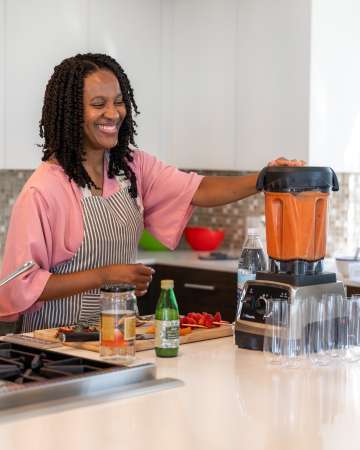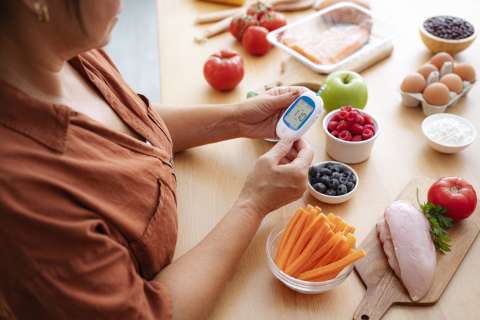UCLA Health urologist Kymora Scotland, MD, PhD, counsels her kidney stone patients about how dietary changes can help prevent the painful condition.
But sometimes there’s nothing like a delicious, homecooked meal to make the point.
In April, Dr. Scotland and some of her colleagues held a free teaching kitchen demonstration for their UCLA Health kidney stone patients. Over Zoom, she chopped ingredients for a curry dish and prepared a fruit smoothie.

“A lot of my patients will tell me they find it a little bit hard to follow a kidney stone diet,” Dr. Scotland said. “We thought a great idea would be to show them things they can do. I really wanted to give them examples of things that were easy and quick but still managed to be healthy and mindful of kidney stone issues.”
About 40 participants followed along at home, preparing the recipes they received in advance.
“I had several of my patients send me a MyChart message saying that they loved it,” said Dr. Scotland, an assistant professor of urology at the David Geffen School of Medicine at UCLA. “They really enjoyed it and thought the recipes were good.”
Kidney stone causes
Kidney stones are small, hard masses and are made from minerals and salts in the urine. An estimated 1 in 10 Americans will have a kidney stone at some point during their lives.
Genetics, diet, dehydration and some health conditions can all contribute to kidney stones.
“The majority of people will have some aspect of their stone formation being as a result of dietary issues,” Dr. Scotland said. “So, for most people, some dietary changes will be helpful.”
According to the National Kidney Foundation, people who have developed one stone are at about a 50% risk for developing another within five to seven years.
Kidney stones are often very painful to pass through the urinary tract. After a stone is formed, it may stay in the kidney or travel into the ureter, which connects the kidneys to the bladder. If a stone gets stuck, it can block the flow of urine. People may then experience symptoms including sharp pain in the side and back, pain in the lower stomach and groin or pain or burning when urinating.
“They can be excruciatingly painful. That’s part of the reason why people will tell me they want to work on stone prevention,” Dr. Scotland said. “I have some patients who are very committed to stone prevention because they don’t want to deal with it again.”
Dr. Scotland, who is director of UCLA Health’s endourology research, said that while dietary changes can be very helpful, they can also be nuanced for patients.
“A lot of this information is not really readily available to patients and that’s part of why I’m doing this,” she said. “The food they eat is important and moderating some of those food items can certainly help with prevention.”
Diet as medicine
When possible, Dr. Scotland said testing a passed stone allows patients to find out what type of kidney stones they develop. That information can determine what foods may contribute to stone formation.
Calcium oxalate stones are the most common type of kidney stones. They are caused by high levels of oxalate, a natural substance found in many foods including fruits, vegetables, nuts and chocolate. Oxalates can form crystals with calcium in the urine that stick together and become a kidney stone.
“Oxalate is found in lots of really healthy foods. It’s unfortunate that it can also form stones,” Dr. Scotland said.

For instance, spinach and some berries have high levels of oxalate. But eating them with a calcium source can minimize the effect because it binds to oxalate, making it less available for kidney stone formation.
In the April cooking demonstration, Dr. Scotland prepared a strawberry, peach and yogurt smoothie to show a way to offset oxalate with calcium from the yogurt.
“It all needs to be balanced,” she said.
Uric acid kidney stones tend to form in very acidic urine. Diets high in animal protein can be a contributing factor because uric acid is produced as the body breaks down meat, fish and eggs.
Dr. Scotland said those patients benefit from decreasing their acid load and increasing foods that are alkaline. In addition to meat, soda is highly acidic. She said eating more citrus, which contains citrates, can help alkalize the urine.
In the cooking demonstration, she prepared a chicken curry with cauliflower and basmati rice. Chicken is less acidic than red meat and cauliflower is low in oxalate.
“You want to have all your food groups and be plant forward as well,” she said.
Dr. Scotland said patients can monitor how their diets are affecting their kidney stone risk through 24-hour urine studies. The test analyzes urine composition to determine what components may contribute to stone development. The data can also help patients see if their results are improving through diet.
“Nothing is guaranteed for all, but many of my patients who work with me on making these changes will notice a decrease in their stone formation,” she said.
Water intake
Food isn’t the only focus. Drinking plenty of water is a cornerstone of a kidney stone prevention diet.
Dr. Scotland recommends drinking 2.5 to 3 liters of fluid a day, with most of that being water. That can be up to about 12 glasses of water and is one of the toughest recommendations.
Depending on their situations, Dr. Scotland works with patients to increase how much they drink.
“Some people don’t like the taste of water,” she said. “We talk about adding fruit, drinking sparkling water or flavored water.”
Others may have jobs that make it difficult, so she stresses consuming more fluid outside of work hours. Others forget to drink and need to create reminders.
Patient resources
In the office, Dr. Scotland provides food lists to her patients that can help them learn what foods are high in oxalate or acid.
“Those things are not on food labels, unfortunately,” she said.

In the demonstration kitchen, Dr. Scotland uses recipes from a free downloadable cookbook developed by the Urology Care Foundation.
To continue helping patients prepare food they enjoy, Dr. Scotland said she and her colleagues hope to turn their quarterly virtual sessions into in-person events.
“I’m of the opinion we’ve got one life to live and you’ve got to make it fun for yourself,” Dr. Scotland said. “If we make these recommendations too strict, they’re not going to be sustainable. My code word is moderation.”
Other UCLA Health organizers of the kidney stone prevention demonstration kitchen are urologists Carol Bennett, MD, and Lynn Stothers, MD, and UCLA registered dietitian Shelby Yaceczko, DCN, RDN-AP.







